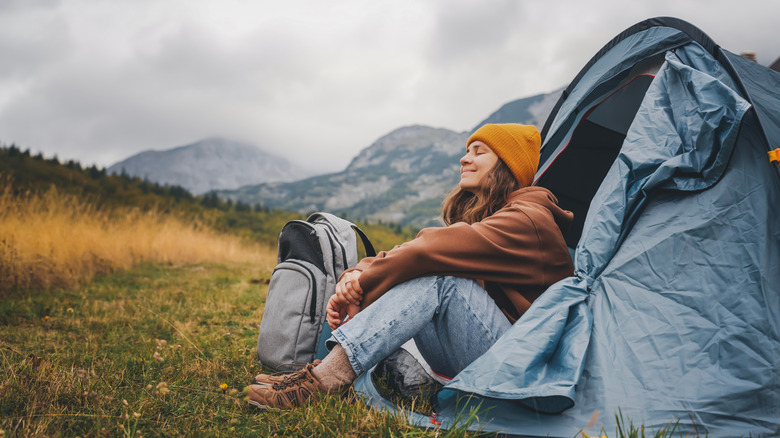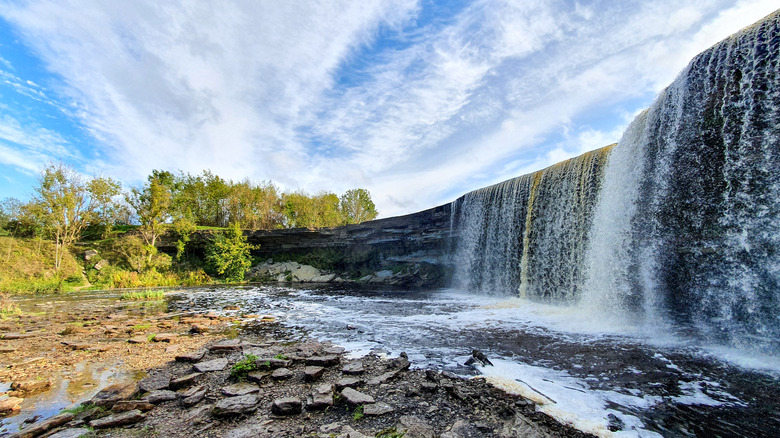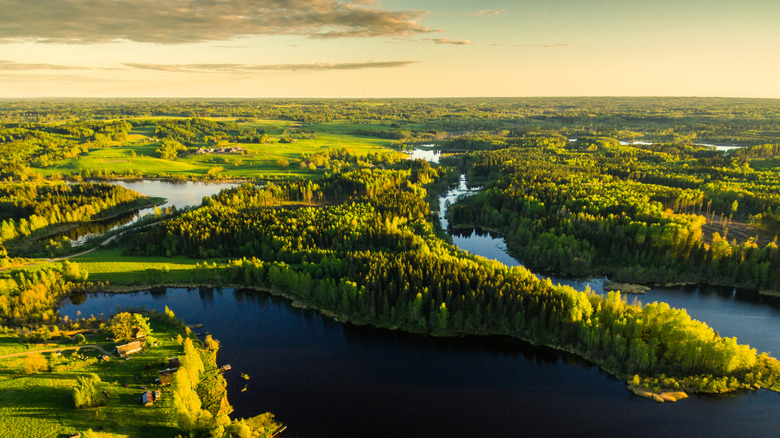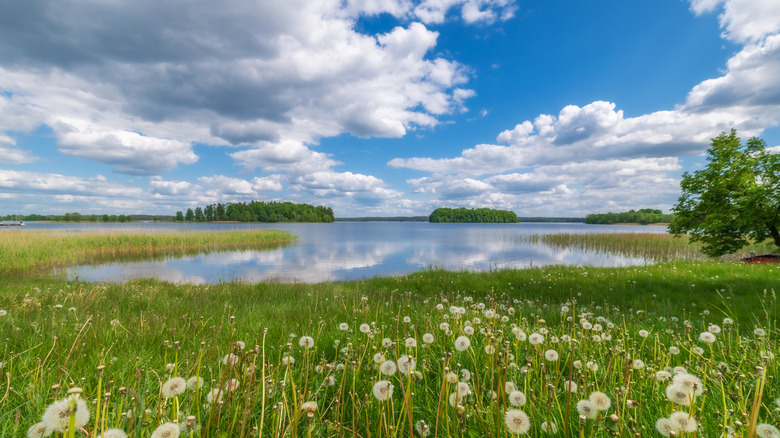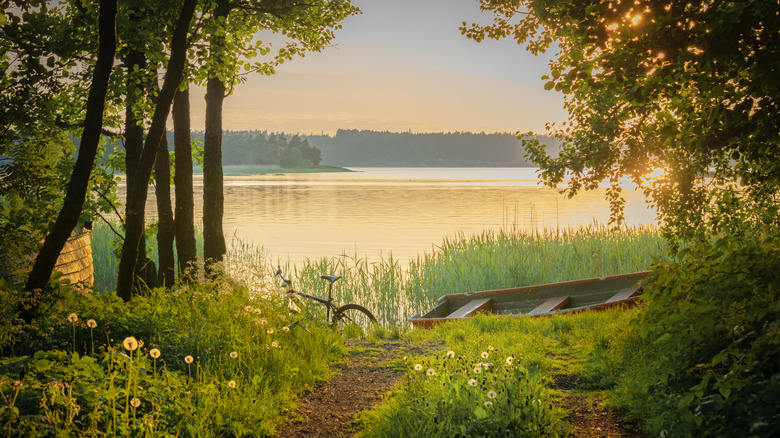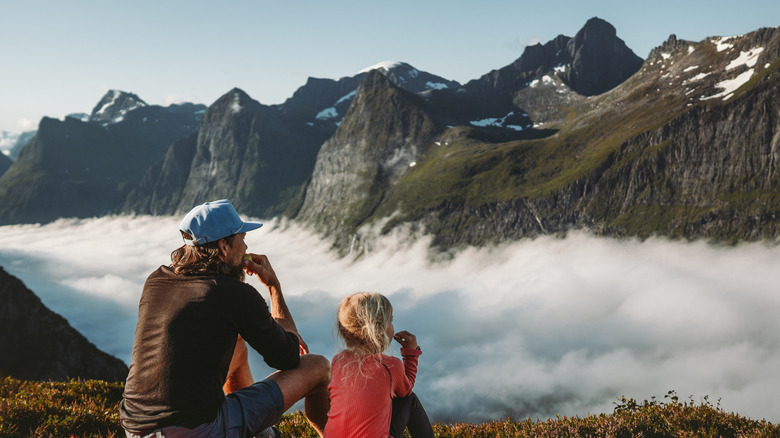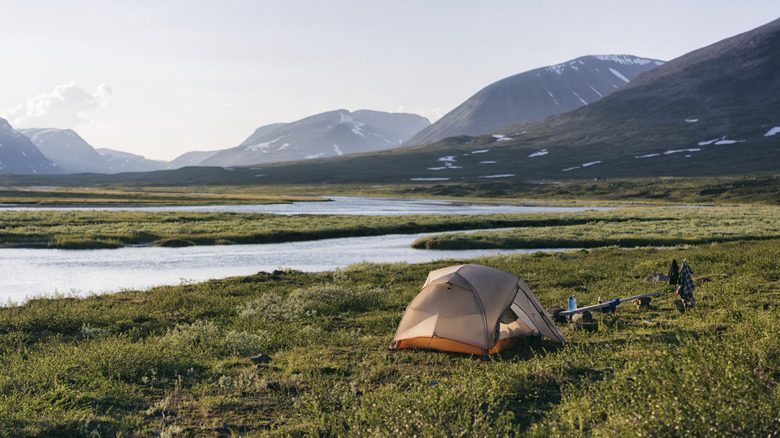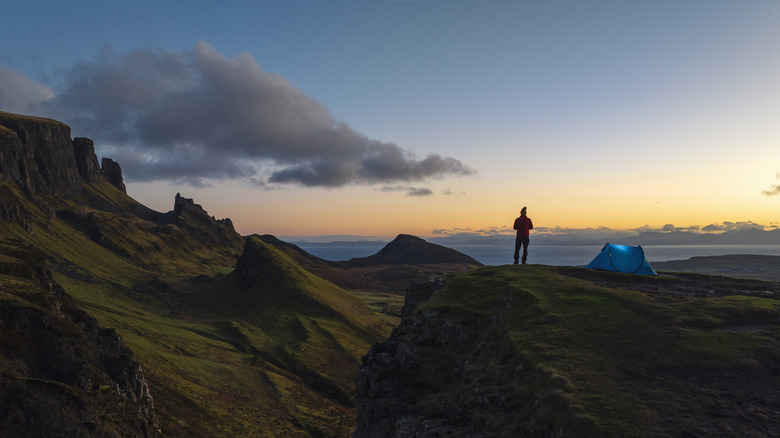7 European Countries Where You Can Camp For Free
We may receive a commission on purchases made from links.
If you have ever looked at a mountain, lake, meadow, or river and thought, "Wow, I wish I could sleep under the stars at that exact spot," wild camping may be your new favorite hobby. Pitching a tent in the middle of nature, perhaps with nobody else in sight, can be a liberating experience. Indeed, for many people, wild camping is a revolutionary concept; you might be astounded to learn that in many countries, you can even camp on privately owned land. If you are comfortable with pitching a tent and not afraid of getting a little dirt underneath your nails, camping is a viable and free alternative to booking hotel rooms and rental properties. As you pack your bags and plan where to rent equipment, make sure to include these items you'll want for a quick and easy camping retreat.
There are seven European countries where hiking, cycling, kayaking, foraging, and camping are widely permissible, each with its own set of laws and rules of etiquette. In general, you are not allowed to camp too close to dwellings or on agricultural land, and you should always practice leave no trace principles. This guide will help you begin to understand each country's regulations so that you can be as responsible as possible during your excursions into nature.
Estonia
Estonia is one of Northeastern Europe's Baltic states, and if you know where to go, it can be a fantastic destination for camping. For instance, Saaremaa is a breathtaking island renowned for spas, folklore, and uncrowded, beautiful beaches. From your campsite there, you might take a dip in the Baltic Sea or hike on one of the island's many trails. If you are traveling elsewhere in Estonia, fear not: The country is brimming with rivers, lakes, swamps, wetlands, bogs, and forests to keep your camping adventure interesting. In fact, there are over 1,500 Estonian islands that you can explore. While June through September is generally considered the warmest and best time to visit Estonia, the shoulder seasons are also manageable if you have the right clothing and equipment.
No matter what, you should plan ahead to mitigate the risks posed by insects like ticks and mosquitoes. Get vaccinated against tick-borne encephalitis before leaving for vacation, and pack clothes that limit your exposure. Use mosquito repellent, and consider purchasing Ben's high-visibility InvisiNet head net to keep those pesky bugs away from your eyes, nose, and mouth.
When wild camping, make sure not to set up camp near dwellings or within zones that house fragile ecosystems. Additionally, take any waste you create with you, double-checking that the area where you camped shows no signs that you were present. Leave a clean camp, always.
Latvia
Latvia is another of the three Baltic states in Northeastern Europe. Bordered to the south by Lithuania, to the east by Russia, and to the north by Estonia, it features gentle, low-lying hills, a substantial coastline, many forests, and a multitude of rivers and lakes. Amongst these natural wonders, you can find over 27,000 species of flora and fauna, including wild boars, deer, beavers, and the rare black stork. The climate in Latvia is warm from June until August, but be prepared for occasionally heavy precipitation and, in many areas, humid and buggy conditions. As we recommended for a camping trip in Estonia, get vaccinated against tick-borne encephalitis, dress mindfully, and apply insect repellent liberally.
As with wild camping in Estonia, you will need to pitch your tent well away from private homes and only in areas where the wildlife and ecology can reasonably withstand your intrusion. Pack out all waste, and when you leave, make sure the area is the same, if not better, than when you arrived. Latvia offers unspoiled national parks and beaches, each with its own regulations on wild camping, so do your research ahead of time.
If you are looking for a cultural experience in addition to your time in nature, visiting during the summer solstice celebration of Jāņi can be particularly fruitful. A vacation in Latvia might also expose you to the strong interests the culture and economy take in amber, a gemstone you may find while walking along a beach after it storms.
Lithuania
Rounding out the Baltics, Lithuania is composed of a captivating array of geographical features, including lakes, marshes, forests, swamps, and the Baltic Sea. Lithuania is also where you'll find Vilnius, one of Europe's most affordable cities and an underrated gem full of history and hikes. We recommend planning your vacation to include this beautiful city on your itinerary; though there is something magical about exploring wilderness far removed from civilization, being in close proximity to a city allows you to more easily add excursions to your camping trip, such as kayaking and cycling trips. Indeed, Lithuania is a paradise for those activities, with plenty of lakes for kayakers to enjoy and the Lithuanian Seaside Cycle Route for cyclists' pleasure. On the other hand, if you would prefer to immerse yourself in one of Lithuania's many forests, you could happily spend your time among the trees hiking, birdwatching, and foraging for berries and mushrooms.
Wild camping in Lithuania is governed by Baltic state regulations similar to the ones mentioned previously. Avoid camping near inhabited dwellings or in designated areas with fragile wildlife populations and ecological features, don't camp on the beach, and properly dispose of all waste. Insect advice also remains the same: Get vaccinated against tick-borne encephalitis, use insect repellent, and wear appropriate clothing. Camping in Lithuania is especially warm and comfortable from June until August, though you can reasonably do so for a few months on either side of this window if you have the right equipment.
Finland
Unless you route your expedition through the Scandinavian Mountains, you won't find many steep peaks to summit on your camping trip to Finland. Just because the country is low-lying, though, doesn't mean that it is lacking in points of geographical interest. Finland is home to roughly 188,000 lakes, popular places for camping, boating, and fishing. The country also boasts magnificent swathes of largely coniferous forests, with a few patches of deciduous forests in the south. Together, these lakes and forests make up an astounding 75% of Finland's total area. As you explore Finland's great outdoors, you might encounter wildlife ranging from lynx and elk to seals and Arctic terns. The Kvarken Archipelago can be a great place to start your camping trip, with its thousands of islands and endless coastline where kayakers thrive.
Camping in Finland is made easier by a set of principles known as "everyman's right," or "jokaisenoikeudet" in Finnish. Camping too close to private dwellings, as well as on land where vulnerable species or environmental features are being managed, should be avoided. Additionally, national parks often have campsites and cabins that you should use rather than wild camping. Recreational activities like canoeing, cycling, hiking, and swimming are encouraged, but permits are required to hunt and fish — unless you are angling. Finally, as always, one should abide by leave no trace principles and only light fires in designated areas when safe.
Norway
Norway is an alluring country for campers; its famous fjords are complemented by valleys, mountains, beaches, bogs, forests, and cliffs. As is the case across Scandinavia, the country's southern region offers a milder climate that can be relished while pursuing outdoor activities like hiking and cycling. If you are up for a chillier adventure, however, head to Haukland Beach in northwestern Norway. This underrated oasis with pristine waters and stunning hikes features a cafe from June until September, plus a camping area for small tents.
Norway's rules for wild camping are contained within a larger set of regulations known as "the right to roam." You may also hear the right to roam referred to as "the right of access" or "allemannsretten." These regulations pertain to two categories of land: That which is fenced and that which is unfenced. Fenced land includes agricultural land, industrial areas, and building plots, and access to this type of land is forbidden without landowners' express permission. On the other hand, unfenced land, otherwise known as open country, is free game for outdoor recreationists, provided they follow responsible guidelines.
These guidelines are mostly common sense. Campers should remain a respectful distance from inhabited homes, and they should dispose of waste (including fecal waste) properly. Unless in the mountains or extremely remote regions, campers should also not stay in one place for more than two nights without permission. Campfires are usually forbidden during the summer months except in designated areas. Unless there is extreme drought, however, you can use a camp stove, perhaps even foraging for mushrooms and berries to supplement your meals. Dress warmly, as average high temperatures during the summer hover around 70 degrees Fahrenheit.
Sweden
With over 24,000 islands and 100,000 lakes, as well as numerous forests, wetlands, and mountains, Sweden's geography is diverse enough to keep outdoor enthusiasts coming back for more. Swedish culture holds a deep reverence for nature, and Sweden is widely considered to be among the most sustainable countries on earth. In fact, Sarek National Park in Swedish Lapland was Europe's first national park. Campers are expected to practice extreme respect for the environment when recreating and be fully aware of leave no trace principles.
"The right of public access," otherwise known as "allemansrätten" in Swedish, ensures that folks have ample opportunity to enjoy the country's plentiful natural wonders. This set of legal guidelines dictates that one can camp anywhere except on agricultural land, near inhabited houses, or in private gardens. The right of public access also permits skiing, cycling, riding, and walking on applicable lands, as well as foraging for wild produce like nuts, mushrooms, and berries. The laws do not extend to fishing, but it is generally permissible to do so along most coasts and in the Hjälmaren, Mälaren, Storsjön, Vänern, and Vättern lakes. Campers should be in small groups and, unless they have obtained permission from landowners, not stay in one place for more than a few nights. Extra restrictions apply in national parks; for instance, one cannot make fires or pick produce, and tents are not always allowed.
Sound enticing? Start your Scandinavian camping holiday in West Sweden, where you can explore fairytale castles, national parks, and trendsetting cities. Go between June and September; July often sees high temperatures approaching 70 degrees Fahrenheit.
Scotland
Scotland is an oasis of woodlands, beaches, moorlands, and lochs. These geographic features alone are enough to beckon many outdoor enthusiasts, but as an extra incentive, you can hike over 20 miles for a pint at Britain's most remote pub. To break up the journey, you might be interested in pitching a tent. Camping in Scotland is comfortable from June until September, provided you have the right equipment. Take advantage of the region's long daylight hours, but note that even if the sun doesn't set in much of the country until after 10 p.m. on the longest days of the year, the average high during a Scottish summer is only 63 degrees Fahrenheit. You'll therefore need to pack warm clothes and a cozy sleeping bag.
Wild camping rules are rather lenient in Scotland and are outlined by the Scottish Outdoor Access Code. These regulations allow one to camp freely on non-agricultural land, so long as that person is solo or in a small group, following leave-no-trace principles, located well away from buildings and roads and not in an enclosed field, and using a tent. Even so, it's worth researching the area in which you plan to set up camp — wild camping in some regions, like Loch Lomond and The Trossachs National Park, is subject to seasonal regulations.
Landowners may not allow vehicles, so if you don't plan to hike, bike, or paddle to your campsite, see if public transportation can suffice. Due to wildfire risk, open fires are discouraged, especially during droughts and in areas of high vulnerability. Additionally, campers should bury their business with a trowel if no restrooms are available.
